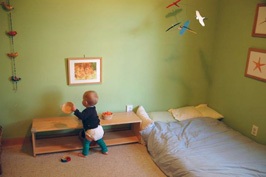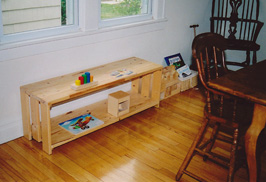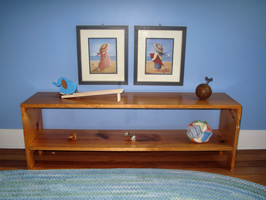Setting Clear Limits





Children need to know what they are allowed to do and what they are not allowed to do. Predictable limits help them to feel secure and give them a model for acceptable behaviour.
Create an environment with clear limits
- Setting limits for children can be very difficult to get right. As parents we are influenced by what we were allowed to do as children and what kind of limits our parents placed on us. We are also influenced by what other parents allow their children to do and so we are constantly trying to find the right balance. It is important to find a middle ground between being overly permissive and very strict.
- Don't always say yes. Sometimes it may seem easier to let your child have his own way because then he stops crying and seems happy but when we always say yes to our children they become people who are unable to accept limits. A child with unlimited freedom may become an adult who will not accept the authority of teachers, other adults, employers, and even laws.
- Don't always say no. On the other hand when we always say no they become people who are not able to think and make decisions for themselves.
Connect you child to these limits
Limit setting is most effective when your child feels you understand him and have respect for him. Parents sometimes try to discipline by talking, directing, and telling their child what to do. But sometimes actions speak louder than words. Hugs, winks, smiles, and quiet watching of her purposeful activities send your child the message that she is on the right path. Sometimes just offering your hand or asking your child if she needs help is all the support she needs. In the same way, a raised eyebrow or a frown communicates disapproval better than angry words and shouting. Here are some approaches that you might find helpful to adopt.Use household items and toys for their intended purpose.
- Show how to use toys. If your child throws shape-sorting her toy, say, 'Be gentle with your toys', and then pick up one of the shapes and try to put it into each opening until it slips into the right one. Young children sometimes throw on a whim, but it doesn't mean they are destructive, and it is usually easy to refocus them into a constructive activity. If she continues to throw the toy perhaps she is trying to tell you that she wants something to throw and you can redirect her by saying 'Let's go outside and thrown your ball.'
- Use things for what they are meant for. Give her a good model of what things should be used for by showing her that 'Chairs are for sitting, beds are for sleeping and tables are for eating, etc.' If she jumps on the bed, say, 'Beds are for sleeping. You can jump outside'. Make sure that these rules apply to everyone, not just your child. You should not stand on a chair either!
Model, create, and maintain order.
- Show how to put toys away. Keep just a few toys on the shelves and rotate from a closet or cupboard to keep the play area always fresh and tidy. If you model putting things away, your child will eventually do the same. Your two-year-old loves order and likes for her world to have order. She absorbs where things go and by age three will be capable of putting things back most of the time. You can help her by cheerfully saying, 'I wonder where the blocks go when we are finished?' An orderly environment supports your toddler in structuring his own mind.
- Do what you want your child to do. What you do is more important than what you say. If you want your child to only eat seated at the table then you need to do this yourself, not while walking around, talking on the phone, or in the car. Your child cannot accept that it is different for you. If your child stands up during a meal or begins to play with her food, say, 'I see that you have finished eating', and remove the food. Learning to stay at a table when eating gradually increases her ability to control her impulses.
- Set some no-go areas. When you set some absolute no-go areas in the environment you reduce conflict. For instance, you can use a child lock on the cupboard door to keep your toddler from emptying the spices and then you don't have to feel annoyed when she does!
Use positive language to redirect.
- Phrase your requests as positive statements, not negatives. When you are cooking, say, ‘The flour goes in the bowl’ rather than ‘Don’t throw the flour on the floor.’
- When making a request to a two-year-old, say what you want her to do. Instead of ordering, 'Get off the table', lift your climbing toddler off the table and say, 'Feet stay on the floor'.
- When your child wants to climb and run inside, make sure she has plenty of opportunities to be outside. When she is running in the house, say in a pleasant voice, 'This is how we walk in the house' and walk alongside her to model how.
- If your child wants sweets at the supermarket, you can say, 'Today we are buying apples'. This keeps the focus on what you are doing instead of what you are not doing. Often, when your toddler wants to handle objects from the shopping trolley she is looking for the name of the object. You can provide this by saying, 'Would you like to hold the apple? The apple is red. Can you smell the apple? Let's buy four apples. Can you help me put the apples into the trolley?' Narrating what your toddler is seeing or doing will give her a supply of words and phrases, keeping her engaged in what is happening and distracted from what she wanted a moment ago.
Avoid overstimulation
- There will always be times when it is difficult for your child to be in control of herself, especially when hungry, tired, or over-stimulated. Some restaurants and stores are terribly over-stimulating to a small child. Adults have the ability to filter out harsh lights or garish sounds, but the small child is still developing these abilities.
- Avoid giving her caffeine, too much sugar, and exposure to television including computers and mobile phones.
Make Time
- The limits will change as your child grows and develops and can take on more responsibility for herself. You will have to grow with her and make adjustments since what may be appropriate for a 1-year-old may not be an appropriate limit for a 3-year-old. It is important to adjust with your child so that she feels that you trust her and this will give her the confidence to impose her own limits on herself as she grows up.